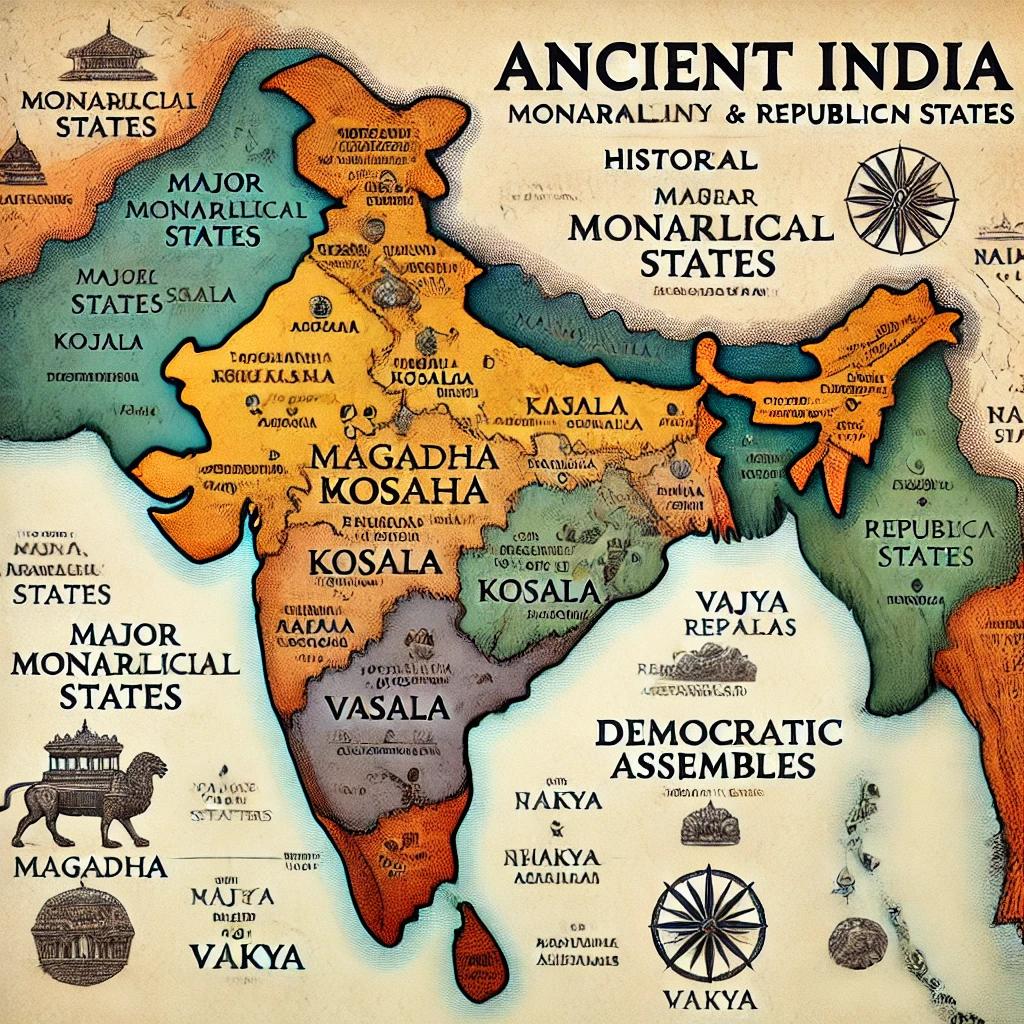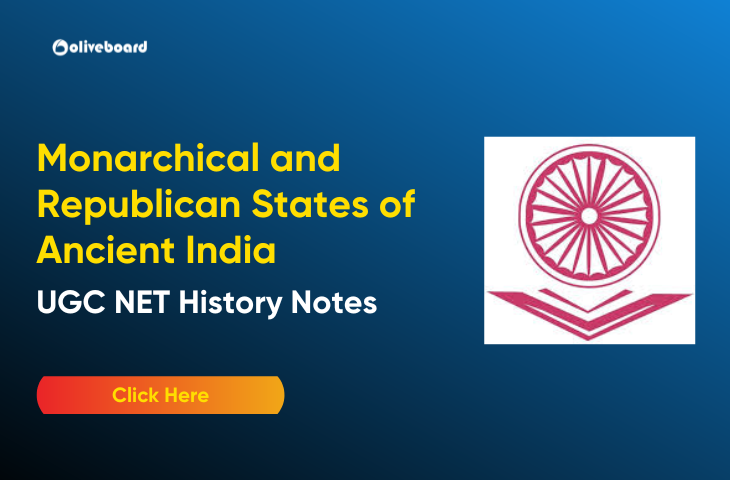The political landscape of ancient India showcased a duality of governance with monarchical states and republican states, particularly prominent during the Mahajanapada period (6th–4th century BCE). Monarchical states, such as Magadha, Kosala, and Kashi, were centralized systems where hereditary kings wielded executive and judicial power, guided by dharma and advisors, and often bolstered by strong militaries and expansive territories. In contrast, republican states, or Gana-Sanghas, like the Vajji Confederacy, Malla, and Shakya, operated through assemblies and collective decision-making, emphasizing deliberation and shared authority. This coexistence of governance systems reflects the political diversity of ancient India and provides critical insights into its socio-political evolution, a vital theme for UGC NET History.
Click Here to Check UGC NET Notification 2024
Features of Monarchical and Republican States in Ancient India
Monarchical and republican states during ancient India, especially in the Mahajanapada period, showcased distinct political systems. Let’s look into its detailed feature:
Detailed Features of Monarchical States in Ancient India
1. Centralized Power:
- In monarchical states, the king held absolute power and ruled with complete authority.
- The king was the central figure in the governance structure and often governed with a small group of ministers or advisors.
2. Divine Right of Kingship:
- The legitimacy of the king was often based on religious or divine sanction.
- Kings were seen as the representatives of gods on Earth, and their rule was justified through religious beliefs and rituals.
3. Hereditary Succession:
- Kingship was generally passed down through hereditary succession, often to the eldest son, ensuring that the royal lineage maintained its rule across generations.
4. Strong Military and Expansionist Policies:
- Monarchies often relied on a strong military for territorial expansion and defense.
- Conquests and wars played a significant role in the growth and power of states like Magadha and Kosala.
5. Structured Administration:
- Monarchies had a clearly defined administrative structure.
- The king was supported by a group of officials, including ministers, military commanders, and regional governors, to manage various aspects of governance, including law, tax, and defense.
Examples of Monarchical States in Ancient India
- Magadha: Known for its powerful kings like Bimbisara and Ajatashatru, who expanded their empire significantly.
- Kosala: Home to kings like Dasharatha, whose kingdom was one of the most prosperous in ancient India.
- Kashi: A smaller kingdom along the Ganges, important for its cultural and religious significance.
Detailed Features of Republican States in Ancient India
1. Collective Governance:
- Republican states operated on a system where power was shared among a group of elected or appointed representatives.
- The decisions were made collectively by councils or assemblies, with no single individual holding supreme power.
2. Leadership by Assemblies:
- Instead of a king, republican states were governed by assemblies known as sabhas or samitis, which were composed of prominent members of society.
- The leadership was usually elected, with term limits and regular changes in office.
3. Decentralized Administration:
- Republican states were more decentralized compared to monarchies.
- Local villages and smaller units had a significant degree of autonomy, and decisions were often made at a community level.
4. No Hereditary Rule:
- Leadership in republics was not based on heredity but on election or merit.
- This allowed for a more flexible and democratic system, where the leader could be selected based on ability and consent from the people.
5. Emphasis on Democracy and Debate:
- Republican states valued debate and deliberation.
- Assemblies held regular discussions on matters of governance, policy, and military strategy, ensuring that decisions were made with input from various segments of society.
Examples of Republican States in Ancient India
- Vajji Confederacy: One of the most notable republican states, the Vajji Confederacy operated under a Gana-Sangha system, where several smaller tribes or clans came together for mutual defense and governance.
- Shakya: The republic in which Buddha was born, where decisions were made by a Mahasabha, or great assembly, composed of elder statesmen and prominent citizens.
- Malla: A republican state famous for its peaceful nature and democratic governance.

Key Differences Between Monarchical and Republican States
The coexistence of monarchical and republican states highlights the plurality of political thought and governance in ancient India. Here are the key differences:
| Criteria | Monarchical States of Ancient India | Republican States of Ancient India |
| Power Structure | Monarchical states had centralized authority with a singular ruler | Republican states featured collective governance through assemblies |
| Leadership | Monarchical states were ruled by hereditary kings | Republican states operated through elected or appointed representatives |
| Decision-Making | Monarchical states were characterized by top-down decision-making with kings holding supreme authority | Republican states relied on deliberation and debate within their councils |
| Military Focus | Monarchical states often expanded their territories through military conquest | Republican states focused on maintaining internal stability and consensus governance |
| Examples | Magadha and Kosala | Vajji Confederacy and Shakya |
Significance of Monarchical and Republican States of Ancient India
- Monarchical states led to the development of centralized governance and large empires .
- Republican states promoted decentralized governance and early democratic practices.
- Monarchical states facilitated economic expansion, trade, and urbanization, whereas republican states fostered local autonomy, social cohesion, and more equitable power distribution.
Click here for Mahajanapadas History Notes
Monarchical and Republican States of Ancient India Conclusion
The monarchical and republican states of ancient India played a crucial role in shaping the political landscape of the subcontinent. Monarchical states, with their centralized authority and hereditary rule, laid the foundation for large empires and a structured administration, as seen in powerful kingdoms like Magadha. In contrast, republican states, based on collective governance and participatory decision-making, highlighted the early presence of democratic principles in ancient India, offering a unique contrast to monarchies. Both systems contributed to the development of political philosophy, socio-economic structures, and religious growth. The legacy of these systems continues to resonate in modern Indian governance, making them a critical area of study for UGC NET History aspirants.
UGC NET History Syllabus 2024, Download PDF
UGC NET MCQ based on Monarchical and Republican States of Ancient India
Q1. Which of the following is a significant contrast between monarchical and republican states in ancient India with respect to governance?
A) Monarchies were governed by divine kingship, while republics were governed through a system of elected representatives.
B) Monarchies relied on democratic assemblies, while republics were controlled by a single ruler.
C) Republican states were centralized, while monarchies were decentralized.
D) Monarchies had a form of indirect rule, while republics practiced autocratic governance.
Answer: A) Monarchies were governed by divine kingship, while republics were governed through a system of elected representatives.
Q2. The Vajji Confederacy, a major republican state in ancient India, is often cited for its contributions to early democratic practices. Which of the following features characterized the governance of this confederacy?
A) Governance by a single hereditary monarch with absolute power.
B) Governance through a collective assembly of representatives from various clans.
C) Leadership based on military prowess and conquest.
D) The practice of hereditary succession to leadership positions within the confederacy.
Answer: B) Governance through a collective assembly of representatives from various clans.
Q3. The political treatise Arthashastra, associated with Kautilya (Chanakya), is primarily focused on the governance of:
A) Republics in ancient India.
B) Monarchical states with centralized rule.
C) Buddhist republics.
D) Tribal confederacies and their leadership systems.
Answer: B) Monarchical states with centralized rule.

Hello there! I’m a dedicated Government Job aspirant turned passionate writer & content marketer. My blogs are a one-stop destination for accurate and comprehensive information on exams like Regulatory Bodies, Banking, SSC, State PSCs, and more. I’m on a mission to provide you with all the details you need, conveniently in one place. When I’m not writing and marketing, you’ll find me happily experimenting in the kitchen, cooking up delightful treats. Join me on this journey of knowledge and flavors!
